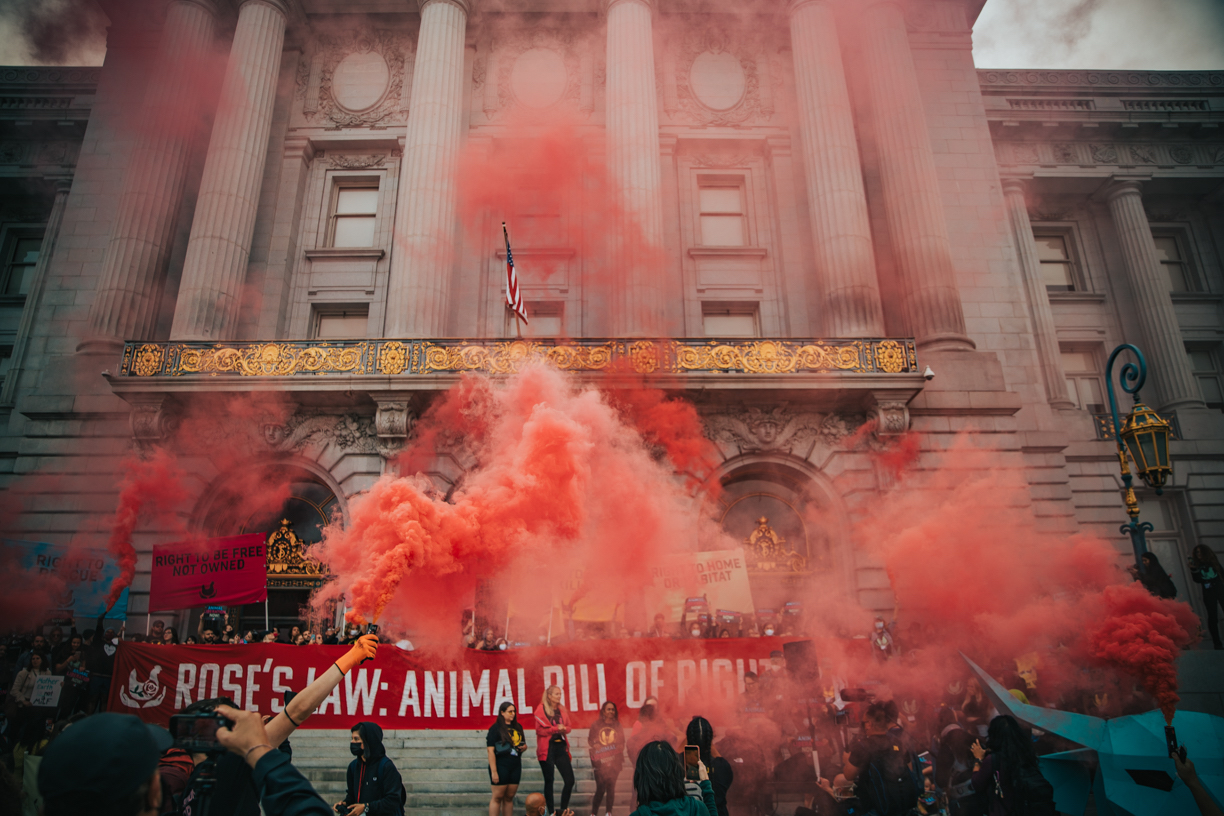Theories of Change

DxE’s first principle is that we believe in, and fight for, total animal liberation. With this goal in mind, we have built communities, exposed horrific violence, and taken direct action wherever animals are harmed. Many people ask us, and we ask ourselves, how what we do will achieve animal liberation. We’ve set out on the challenge of trying to check that we are achieving what we hope to achieve.
To figure out how we are doing at our goals, we are going to develop metrics - simple things that could range from the number of people at our actions to the engagement in our network. In order to refine our measurement, we are first specifying what’s called a “Theory of Change” (ToC) - the concrete way in which what we are doing will achieve animal liberation. In order to refine our Theory of Change, we wanted to present the main ways that nonviolence may bring about the sort of change we want to see. There is clear evidence that nonviolence works - the question is how, and we want your comments.
A Theory of Change is a specific description of a social change initiative that forms the basis for strategic planning, on-going decision-making and evaluation. A Theory of Change should be specific and should tell us how what we are doing will help to produce the outcome we want: a Species Equality Act or other major act of government enacting equality for all animals.
We’d also like to note is that as important as the Theory of Change is, it’s important to consider the ways different strategies might backfire. Undermining other activists, leading to public stasis, and creating a reaction stronger than our movement are all risks any activist must beware. We’ve made changes in the past on the basis of important criticisms, such as our decision to begin including animal imagery after avoiding it in our early protests and our revisions to blog posts after discussions with others in the movement. We welcome all theories and criticisms.
Here are a few theories worth considering. Feel free to suggest others!
Theories of Change:
1. Motivating activists to influence those around them.
In an influential study on the Tea Party, researchers suggested that Tea Party protests had a dramatic impact on public opinion not through their direct effect but because participants went home and spoke to their family and friends in a way that moved them in support of Tea Party policies. The first way DxE actions work is that activists go home and talk to people in their own lives in a way that moves them in the direction of robust support for animal liberation. This could include awareness, sympathy, or simply acceptance of the idea of animal liberation among activists’ friends and family.
2. Building a movement that can change the future.
One of the key things past social movements have had is a strong network -- such as the Southern Christian Leadership Conference or ACT UP -- and a underlying community - from the Black church to gay and lesbian community centers. Our movement lacks both a grassroots network and a supporting community, and one of DxE’s aims is to work with other groups to build networks and communities, as well as the other elements of a social movement, so we can effect change in the future by persuading, compelling, and leading the public and public officials to adopt liberationist policies.
A key question we are interested with this aim is what a network or community capable of producing change would look like, so we can know that we are building the right sort of institutions.
3. Creating a movement that can take advantage of political opportunities.
Aberrant events - from the fall of the Soviet Union to the Great Depression - powerfully change the course of history. Successful movements can take advantage of these events to powerful effect. Amid the tragedy of the AIDS crisis, gay rights activists got a seat at the public policy table that allowed major gains in the coming decades while #BlackLivesMatter turned the killing of Trayvon Martin into a national crisis that has changed police policies around the country. DxE could aim to create a movement, as with our previous theory of change, but one with the key attribute of being able to seize on unexpected opportunities.
4. Creating a fierce backlash that moves public opinion in support of animal liberation.
Past movements’ success has ridden in large part on the back of ugly reactions by their enemies. Despite their realistically slim numbers, the abolitionists scared the South into seceding, a doomed effort that ultimately freed the slaves. Civil Rights era protests sparked a violent reaction, famously symbolized by Bull Connor’s fire hoses and attack dogs. One way the DxE model could work is by sparking such an angry reaction that the rest of the country moves in the direction of supporting animal liberation. This could operate by changing each person’s opinion of animals, but it could also create pockets of sympathy with animal liberation that become useful in pushing policies.
5. Directly changing people who witness protests.
This perhaps the most obvious theory. People who witness DxE protests are forced to confront the issue and leave more aware and perhaps more sympathetic to animal rights. It’s important to note that there could be benefits to alienating people who witness DxE protests - an ugly reaction can generate sympathy - and that immediate reactions to protests are often unreliable indicators of their effectiveness. Nonetheless, this is an important theory to consider.
6. Directly changing people who encounter DxE actions in the media.
This theory is very similar to the previous theory. People who encounter DxE via press gain a heightened awareness and sympathy with animal rights. It has the same drawbacks, too, at least in the present term. An ugly reaction can be good, and the effects of press can vary widely depending on the tone of the story, the size of the crowd, and the particular media outlet.
Ultimately, it’s likely there are several ways our activism works, and multiple risks our activism should avoid. For that reason, we’d like to hear refinements to the above theory and the thoughts, concerns and suggestions of those inside and outside of DxE on how we can achieve animal liberation.
Other articles

Tulare County Dairy Farms Are Poisoning Latino Communities

The Case for Systemic Change




